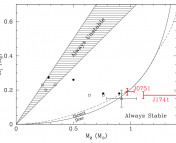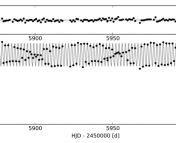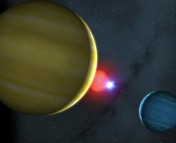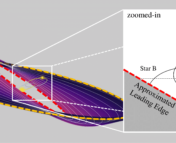Title: Strong Variability in AzV 493, an Extreme Oe-Type Star in the SMC
Authors: M.S. Oey et al.
First Author’s Institution: Astronomy Department, University of Michigan
Status: Published in ApJ [open access]
This guest post was written by Samuel Spencer. Samuel is an undergraduate studying Physics at the Central Washington University. His most recent project involved developing methods for future undergraduate students so that they can be better introduced to the subject of the Zeeman effect. In his free time, he enjoys creative writing and playing video games.
One of the most fundamental components of massive star formation is binary interaction. These interactions between two massive stars bound by gravity result in strange phenomena, such as high-mass X-ray binaries (HMXBs), ultra-luminous X-ray sources (UXLs), and so much more. Studying these stars gives insight not only into their formation, but also their structure and behaviors.
The authors of this paper studied massive stars by focusing on one very peculiar star, the Type Oe star AzV 493. Type Oe stars are the largest stars, but emit lines of hydrogen instead of helium. While this star is currently not known to be in a binary system, its incredibly odd behaviors might suggest otherwise. So, collecting and analyzing as much data as they could (roughly 18 years’ worth!), the authors set out to see if AzV 493 might indeed be in a binary system.
Observing AzV 493
The photometry data compiled by the authors shows that AzV 493 is a variable star. The most interesting behavior they found is highlighted in Figure 1. Around 2002 and 2016, AzV 493 was observed to have incredibly sudden and extreme drops in its apparent magnitude. After each drop, the magnitude of the star would slowly rise back up. In order to see how the two drops might be different, the authors overlaid the data from 2016 onto the 2002 drop. The two growth periods seem to be extremely like one another, which suggests something is happening to the star periodically, occurring roughly every 14.5 years. Using both the photometry data, and collected spectroscopy data from the Magellan telescopes at the Las Campanas Observatory in Chile, the authors were able to estimate that the temperature of AzV 493 is around 42 000 K (over 7 times hotter than the sun), that the star is almost 100 000 times brighter than the sun, and the radius is around 15.3 times that of our sun. Using these estimations, they then calculated the mass of AzV 493 to be roughly 50 times the mass of our sun.
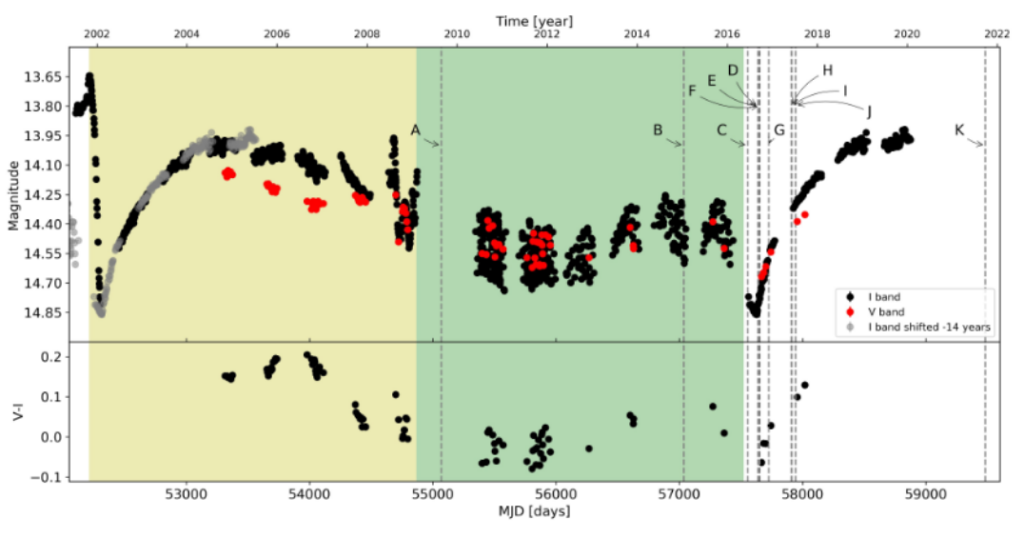
Also highlighted on Figure 1 are several vertical dashed lines, denoting epochs (epoch meaning date) of particular interest. At these epochs, the authors placed their focus on Hβ emissions, as AzV 493 emits this particular emission the most, making data easier to analyze. The authors, using the raw spectroscopy data for these epochs, noted that a majority of the spectra for these epochs included double peaks. To make the data clearer, the authors wanted to disentangle the violet (V) and red (R) components of the V/R variations associated with stars of this size. To do so, they subtracted their best model of the spectrum data from the data, then fitted the V and R components with several Gaussian models. The results of this can best be seen on Figure 2.
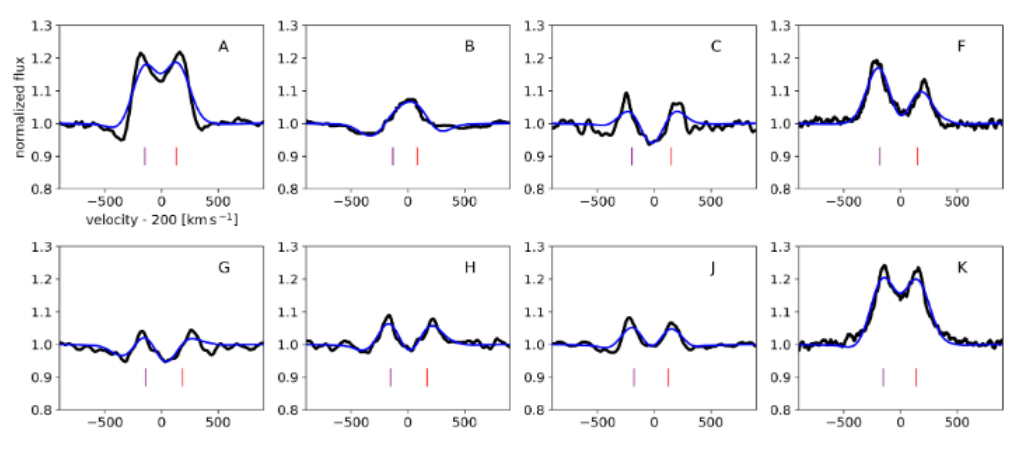
The most interesting epoch we can see from Figure 2 is most certainly Epoch B. While all other epochs show double-peak emissions (one peak is from the V component of the data, the other peak is from the R component, both come together to make a double-peak), Epoch B shows a P-Cygni emission profile, which implies an interesting feature of the star: that it undergoes episodic outflows. This means that the sudden drops in magnitude of the star are likely connected to some sort of ejection.
What the Authors Think is Happening
The authors think that the strange drops in magnitude are caused by the star ejecting a decretion disk. If this is the case, the slow growths that follow each drop are believed to be matter from the disk falling back into the star. How is AzV 493 ejecting and reabsorbing material regularly every 14.5 years? The authors believe it’s because AzV 493 has an unseen, massive companion that it’s orbiting with an extreme eccentricity. They believe that the unknown companion pulls material away from AzV 493 when its orbit reaches perihelion, causing the pulled material to form the decretion disk previously mentioned. As Azv 493 pulls away, the companion star’s pull has less effect on the ejected material, and the material is left to fall back into AzV 493.
Who is AzV 493’s Dancing Partner?
The authors are still not completely sure, though they did come up with multiple ideas. Because the star is spinning so fast, it is believed that AzV 493 was involved in a mass transfer event, which means that at some point, the star received matter from its binary companion. This means AzV 493’s possible companions include a stripped star, a neutron star, black hole, or that the system is a merger. However, some of these theories don’t work out. For example, confirmed mergers (such as η Car) seem to be different kinds of stars from AzV 493. AzV 493’s companion is also very unlikely to be a stripped star, as stripped stars do not have strong SN kicks, which would be needed to knock the star into the extremely eccentric orbit the authors think is present. This leaves black holes or a neutron star as possible companions. Black holes having natal SN kicks are also a highly contested topic, leaving neutron stars as the most likely option for AzV 493’s dancing partner.
The next steps the authors want to take, is to simply study the object more so that we can better understand how similar stars form, and their behaviors.
Astrobite edited by: Delaney Dunne
Featured image credit: ESO / M. Kornmesser / S.E. de Mink

